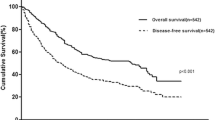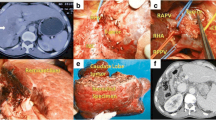Abstract
The results of 122 hepatic resections in 112 patients with hepatocellular carcinoma are described. The type of liver resection performed was selected according to the patient's liver function. Forty-nine patients underwent anatomic resections, including 1 trisegmentectomy, 5 lobectomies, 11 segmentectomies, and 32 subsegmentectomies; the remaining 63 patients had nonanatomic resections. The 1-, 2-, and 3-year survivals after liver resection for all patients, taking into account one operative and one hospital death (0.9% each), were 92.4%, 85.0%, and 78.9%, and disease-free survivals at 1, 2, and 3 years were 68.6%, 46.2%, and 32.6%, respectively. Twenty-one repeat hepatic resections (17.2% of the total of 122 resections) were performed with no hospital mortality. Cumulative survival from the time of repeat hepatectomy in these 21 patients was 84.2% and 56.3% at 1 and 2 years, respectively. Among the factors that may affect survival or disease-free survival, the absence of vascular invasion (p<0.05) and intrahepatic metastases (p<0.01) were significantly related to the disease-free survival time. A good outcome was obtained after liver resection in 112 patients with hepatocellular carcinoma through appropriate choice of the type of resection, careful follow-up, and a vigorous surgical approach for recurrence.
Résumé
Les résultats de 122 résections hépatiques chez 112 patients ayant un carcinome hépatocellulaire (CHC) sont décrits. Le type de résection a été choisi selon la fonction hépatique. Quarante neuf patients ont eu une résection anatomique y compris un cas de trisegmentectomie, cinq lobectomies, 11 segmentectomies, et 32 sous segmentectomies; les 63 autres patients ont eu une résection non anatomique. Les survies à 1, 2 et 3 ans après résection hépatique pour tous les patients, en tenant compte d'un décès hospitalier et d'un décès préopératoire (0.9%), ont été de 92%, 85% et de 78.9% alors que la survie sans tumeur a été de 68.6%, de 46.2% et de 32.6%, respectivement. Vingt et une résections secondaires ont été réalisées (17.2% au total des 122 résections) sans mortalité hospitalière. La survie cumulative depuis le moment de la deuxième résection chez ces 21 patients a été de 84.2% et de 56.3% à 1 et à 2 ans, respectivement. Parmi les facteurs influençant la survie sans tumeur, il faut noter l'absence d'envahissement vasculaire (p<0.05) et l'absence de métastases hépatiques (p<0.001). L'évolution après résection pour CHC est bonne grâce à une indication appropriée, un suivi rigoureux et une attitude thérapeutique agressive en cas de récidive.
Resumen
Se describen los resultados de 122 resecciones hepáticas en 112 pacientes con carcinoma hepatocelular. El tipo de resección efectuado se seleccionó con base en el estado de la función hepática. Cuarenta y nueve pacientes tuvieron resección anatómica, incluyendo una trisegmentectomía, 5 lobectomías, 11 segmentectomías y 32 subsegmentectomías, y los 63 pacientes restantes tuvieron resecciones no anatómicas. Las tasas de sobrevida a 1, 2 y 3 años luego de resección hepática, teniendo en consideración una muerte operatoria y una muerte hospitalaria (0.9% cada una) fuerin 92.4%, 85% y 78.9%, en tanto que las tasas de sobrevida libre de enfermedad a 1, 2 y 3 años fueron 68.6%, 46.2% y 32.6%, respectivamente. Se realizaron 21 resecciones hepáticas repetidas (17.2% del total de las 122 resecciones) sin mortalidad hospitalaria. La tasa acumulada de sobrevida desde el momento de la nueva hepatectomía en estos 21 pacientes fue 84.2% y 56.3% a 1 y 2 años, respectivamente. Entre los factores que pueden afectar la sobrevida o el intervalo libre de enfermedad, la ausencia de invasión vascular (p<0.05) y las metástasis intrahepáticas (p<0.01) aparecieron significativamente relacionadas con el intervalo libre de enfermedad. Se demuestra un buen resultado luego de la resección hepática en 112 pacientes con carcinoma hepatocelular mediante una escogencia apropiada del tipo de resección, un seguimiento cuidadoso y un vigoroso aproche quirúrgico en presencia de recurrencia.
Similar content being viewed by others
References
Makuuchi, M., Hasegawa, H., Yamazaki, S.: Intraoperative ultrasonic examination for hepatectomy. Jpn. J. Clin. Oncol. 11:367, 1981
Makuuchi, M., Hasegawa, H., Yamazaki, S.: Ultrasonically guided subsegmentectomy. Surg. Gynecol. Obstet. 161:346, 1985
Kanematsu, T., Takenaka, K., Matsumata, T., Furuta, T., Sugimachi, K., Inokuchi, K.: Limited hepatic resection effective for selected cirrhotic patients with primary liver cancer. Ann. Surg. 199:51, 1984
Makuuchi, M., Mori, T., Gunven, P., Yamazaki, S., Hasegawa, H.: Safety of hemihepatic vascular occlusion during resection of the liver. Surg. Gynecol. Obstet. 164:155, 1987
Liver Cancer Study Group of Japan: Primary liver cancer in Japan. Ann. Surg. 211:277, 1990
Makuuchi, M., Hashikura, Y., Kawasaki, S., Tan, D., Kosuge, T., Takayama, T.: Personal experience of right anterior segmentectomy (segments V and VIII) for hepatic malignancies. Surgery 114:52, 1993
Makuuchi, M., Kosuge, T., Takayama, T., et al.: Surgery for small liver cancers. Semin. Surg. Oncol. 9:298, 1993
Kakazu, T., Makuuchi, M., Kawasaki, S., et al.: Repeated hepatic resection for recurrent hepatocellular carcinoma. Hepatogastroenterology 40:337, 1993
Makuuchi, M., Hasegawa, H., Yamazaki, S., Takayasu, K., Moriyama, N.: The use of operative ultrasound as an aid to liver resection in patients with hepatocellular carcinoma. World J. Surg. 11:615, 1987
Makuuchi, M., Hasegawa, H., Yamazaki, S., Takayasu, K.: Four new hepatectomy procedures for resection of the right hepatic vein and preservation of the inferior right hepatic vein. Surg. Gynecol. Obstet. 164:68, 1987
Kawano, N., Ohmori, Y., Inoue, O., Nagao, S., Morioka, Y.: Long-term prognosis of surgical patients with hepatocellular carcinoma. Cancer Chemother. Pharmacol. 23(Suppl.):S129, 1989
Tang, Z.Y., Yu, Y.Q., Zhou, X.A., et al.: Surgery of small hepatocellular carcinoma. Cancer 64:536, 1989
Yamanaka, N., Okamoto, E., Toyosaka, A., et al.: Prognostic factors after hepatectomy for hepatocellular carcinomas. Cancer 65:1104, 1990
Arii, S., Tanaka, J., Yamazoe, Y., et al.: Predictive factors for intrahepatic recurrence of hepatocellular carcinoma after partial hepatectomy. Cancer 69:913, 1992
Lee, C.S., Sung, J.L., Hwang, L.Y., et al.: Surgical treatment of 109 patients with symptomatic and asymptomatic hepatocellular carcinoma. Surgery 99:481, 1986
Lange, J.F., Leese, T., Castaing, D., Bismuth, H.: Repeat hepatectomy for recurrent malignant tumors of the liver. Surg. Gynecol. Obstet. 169:119, 1989
Matsuda, Y., Ito, T., Oguchi, Y., Nakajima, K., Izukura, T.: Rationale of surgical management for recurrent hepatocellular carcinoma. Ann. Surg. 217:28, 1993
Liver Cancer Study Group of Japan: Survey and follow-up study of primary liver cancer in Japan. Acta Hepatol. Jpn. 32:1138, 1991
Author information
Authors and Affiliations
Rights and permissions
About this article
Cite this article
Kawasaki, S., Makuuchi, M., Miyagawa, S. et al. Results of hepatic resection for hepatocellular carcinoma. World J. Surg. 19, 31–34 (1995). https://doi.org/10.1007/BF00316976
Issue Date:
DOI: https://doi.org/10.1007/BF00316976




